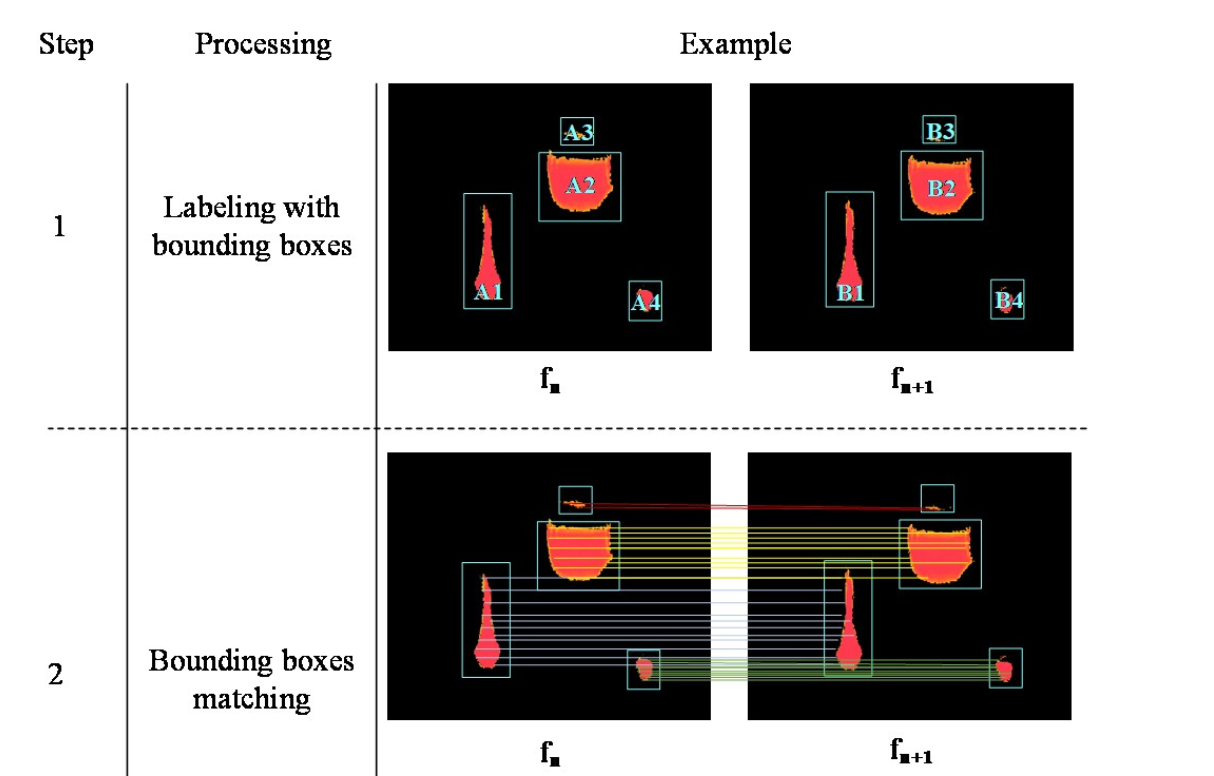A Thermal-Based Fuel-Prediction Method for Intelligent Fire Extinguisher in an Indoor Environment
Main Article Content
Abstract
Classification of fuel in the early stage of fire is important to choose the appropriate type of extinguisher for extinguishing fire. This paper proposes a method of fuel prediction based on heat information for intelligent fire extinguisher in an indoor environment. Fire flame in the early stage is first detected based on patterns of differences between consecutive thermal image frames in which temperature grows up rapidly and reveals a sharp positive slope. Then candidate flame boundaries are detected in the thermal image frames during the early stage, and boundary matching is performed among the frames. These matched boundaries are classified as fire flame and fuel class based on LSTM (Long short-term memory) for extinguisher selection. Experiments were performed with 300 samples for classification into four classes of fuel, and the results based on 9:1 training and testing ratio showed 92.142% accuracy.
Article Details

This work is licensed under a Creative Commons Attribution-NonCommercial-NoDerivatives 4.0 International License.
References
[ 1 ] Evarts B., “Fire loss in the United States during 2018”. National Fire Protection Association. Fire Analysis and Research Division, pp. 7, 2019
[ 2 ] Marty A., “Home Structure Fires Supporting Tables”. National Fire Protection Association. Fire Analysis and Research Division, pp. 7, 2019
[ 3 ] “NFPA 10 Standard for portable fire extinguishers.” National Fire Protection Association, USA. 2013.
[ 4 ] Over a third of workers are using the wrong fire extinguisher, [Online], Available: https://www.fmj.co.uk/third-workers-using-wrong-fire-extinguisher [2020, January 10].
[ 5 ] T. X. Truong and J.-M. Kim, “Fire flame detection in video sequences using multi-stage pattern recognition techniques,” Engineering Applications of Artificial Intelligence, vol. 25, no. 7, pp. 1365–1372, 2012.
[ 6 ] Ko, B. C., Ham, S. J., and Nam, J. Y., “Modeling and formalization of fuzzy finite automata for detection of irregular fire flames”. IEEE Transactions on Circuits and Systems for Video Technology, vol. 21, no. 12, pp. 1903– 1912., 2011
[ 7 ] Kong, S. G., Jin, D., Li, S., and Kim, H., “Fast fire flame detection in surveillance video using logistic regression and temporal smoothing”, Fire Safety Journal, vol. 79, pp. 37–43., 2016
[ 8 ] Kim, Byoungjun, and Joonwhoan Lee. "A video-based fire detection using deep learning models." Applied Sciences 9.14, 2862. ,2019
[ 9 ] Muhammad, K., Ahmad, J., Lv, Z., Bellavista, P., Yang, P., & Baik, S. W., “Efficient deep CNN-based fire detection and localization in video surveillance applications.” IEEE Transactions on Systems, Man, and Cybernetics: Systems, pp. 1419-1434.,2018.
[ 10 ] Muhammad, K., Ahmad, J., Mehmood, I., Rho, S., and Baik, S. W., “Convolutional neural networks-based fire detection in surveillance videos.” IEEE Access, vol. 6, pp. 18174–18183., 2018
[ 11 ] Foggia, Pasquale, Alessia Saggese, and Mario Vento. “Real-time fire detection for video-surveillance applications using a combination of experts based on color, shape, and motion.” IEEE Transactions on circuits and systems for video technology 25.9, pp. 1545-1556.,2015.
[ 12 ] Habiboğlu, Yusuf Hakan, Osman Günay, and A. Enis Çetin. “Covariance matrix-based fire and flame detection method in video.” Machine Vision and Applications 23.6, pp. 1103-1113., 2012
[ 13 ] Di Lascio, Rosario, et al. “Improving fire detection reliability by a combination of videoanalytics.” International Conference Image Analysis and Recognition. Springer, Cham, 2014.
[ 14 ] Jadon, Arpit, et al. “FireNet: a specialized lightweight fire & smoke detection model for real-time IoT applications.” arXiv preprint arXiv:1905.11922, 2019.
[ 15 ] Khatami, A., Mirghasemi, S., Khosravi, A., Lim, C. P., and Nahavandi, S., “A new pso-based approach to fire flame detection using k-medoids clustering”. Expert Systems with Applications, vol. 68, pp. 69–80., 2017
[ 16 ] P. V. K. Borges and E. Izquierdo, “A probabilistic approach for vision based fire detection in videos,” IEEE transactions on circuits and systems for video technology, vol. 20, no. 5, pp. 721–731, 2010.
[ 17 ] Rafiee, Ali, et al. “Fire and smoke detection using wavelet analysis and disorder characteristics.” 3rd International Conference on Computer Research and Development. Vol. 3. IEEE, 2011.
[ 18 ] Celik, Turgay, et al. “Fire detection using statistical color model in video sequences.” Journal of Visual Communication and Image Representation 18.2, pp. 176-185., 2007
[ 19 ] Chen, Thou-Ho, Ping-Hsueh Wu, and Yung-Chuen Chiou. “An early fire-detection method based on image processing.” International Conference on Image Processing, ICIP'04. Vol. 3. IEEE, 2004.
[ 20 ] Maspiyanti Febri, et al. Plasmodium falciparum stages classification on red blood cell image using region property. In: 2016 1st International Conference on Information Technology, Information Systems and Electrical Engineering (ICITISEE). IEEE., p. 105-109., 2016
[ 21 ] Hui, Dong; Yuan, Han Dian. “Research of image matching algorithm based on SURF features.” In: 2012 International Conference on Computer Science and Information Processing (CSIP). IEEE, p. 1140-1143., 2012
[ 22 ] Srivastava, Divya; Wadhvani, Rajesh; Gyanchandani, Manasi. “A review: color feature extraction methods for content based image retrieval.” International Journal of Computational Engineering & Management, 18.3: 9-13., 2015
[ 23 ] K. Pattanaworapan, K. Chamnongthai, J.-M. Guo, “Signer-independence finger alphabet recognition using discrete wavelet transform and area level run lengths.” Journal of Visual Communication and Image Representation
, 658–677., 2016
[ 24 ] Mingqiang, Yang; Kidiyo, Kpalma; Joseph, Ronsin. “A survey of shape feature extraction techniques.” Pattern recognition, 15.7: 43-90., 2008
[ 25 ] Liu, Larkin; Lin, Yu-Chung; Reid, Joshua. “Comparing the Performance of the LSTM and HMM Language Models via Structural Similarity”. arXiv preprint arXiv:1907.04670, 2019.
[ 26 ] WU, Jia, et al. “Hyperparameter optimization for machine learning models based on Bayesian optimization.” Journal of Electronic Science and Technology, 17.1: 26-40., 2019
[ 27 ] WILSON, D. Randall; MARTINEZ, Tony R. “The need for small learning rates on large problems.” IJCNN'01. International Joint Conference on Neural Networks. Proceedings (Cat. No. 01CH37222). IEEE. p. 115-119., 2001


